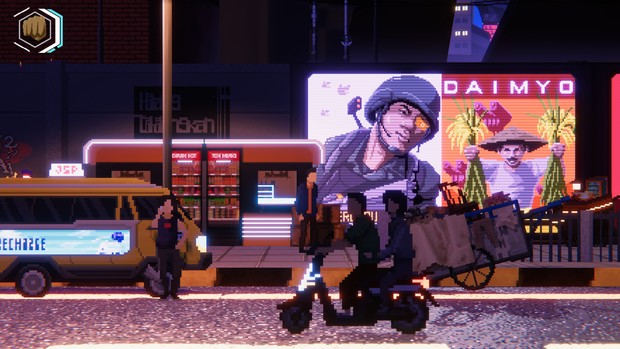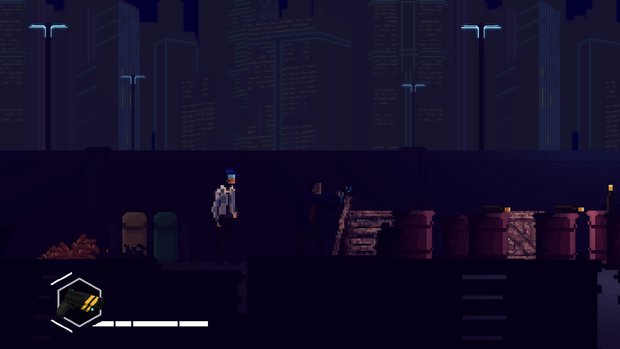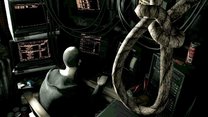Rendezvous review

- 0 Comments
Action meets adventure in this uneven side-scrolling pixel art vision of cyberpunk Indonesia
Imagine a futuristic city, neon-lit in the dark and the rain, with giant, floating billboards and hovercars scudding past. I bet you're already picturing Blade Runner, maybe hearing Vangelis's floaty synth score or Roy Batty reflecting on tears in the rain, imagining future Los Angeles with a dash of Tokyo. But there's more to cyberpunk and its dreams of a grimy hi-tech future than that, as Rendezvous, from small Indonesian studio Pendopo Creations, ably demonstrates. Swapping Los Angeles for Surabaya, it presents a compellingly realised (if indeed heavily Blade Runner-inspired) vision of Indonesia's future, where body hackers and cyberrunners rub shoulders with triad gangs and old-fashioned political graft. Its mix of light puzzling and combat will likely prove frustrating for many, but its heady atmosphere and intriguing (if at times too briefly told) story is almost bound to draw you in anyway.
It's 2064, and Setyo is desperate to put a murky past behind him. No longer is he running with drug gangs, working with foreign agents, or rubbing people out. Instead, he's moved from the sprawling megacity of Neo-Surabaya to the US west coast and Bay City, put on a uniform, and started a new life as a lowly but legitimate security guard. These days, his life consists of tedious shifts at work, kicking back in a local bar, and trying to support his sister Arum back home.
Of course, a past like Setyo's can't be buried without a fight, and his new, pleasantly dull existence is soon turned upside down when his old agent buddy Jack Pierce turns up in his favourite watering hole with news that Arum has disappeared under mysterious circumstances. Time to dive back into the neon noir world of Neo-Surabaya, track down his sister, and try desperately not to get sucked back into his old life. But questions abound: Just what has Arum got herself involved in? Is Jack the friend he appears to be? And how deep does the rabbit hole go?

Right from the off, Rendezvous presents a striking Blade Runner-esque world. There are the same sort of neon-drenched nighttime streets, and the same curious mix of futuristic and defiantly traditional. Coolie-hatted vendors hawk exotic street food alongside recruitment holograms, while around the corner prayer groups are guarded by hovering drones. Neo-Surabaya itself arose from the destruction wrought by an earthquake in the 2030s, and its streets are filled with disabled war veterans, struggling peasant children, and black marketeers. Anything can be obtained, for a price, and shady megacorps are more powerful than the government.
This intriguing blend of ancient and contemporary extends to the graphics, too. They're drawn in pixels so chunky that faces turn into amorphous blobs, but they're lit with modern lighting and shadows and move smoothly in parallax layers. During conversations, the character portraits are clean and sharp, as are the text and other interface elements. Like Surabaya itself, what could have been messy and chaotic instead comes across as energetic and charming. Aside from a scene or two right at the start, all the action happens at night, with the soft pools of multicoloured light from doors and windows competing with the brighter, harsher glare from signs and adverts. The streets are heaving with cars, rickshaws, and pedestrians bustling by. After the everyday Americana of Bay City in the first chapter, the action soon switches to the bustling metropolis of Neo-Surabaya, with its bustling backstreets, grand plazas, run-down apartment buildings, and gleaming skyscrapers. Giant monuments to capitalism are blockaded by placard-wielding protesters while police hovercars patrol overhead, and body-modding salons rub shoulders with quaint cafes.
All of this is overlaid by a moody synthwave score that gives it an appropriately futuristic yet melancholy vibe, becoming progressively more menacing as the action heats up. There's some solid if unremarkable voice acting during a handful of cutscenes spread over the game's six chapters, but otherwise conversations are typed out along the bottom of the screen. This mostly works well, except during a small number of timed challenges I'll get to later.

The side-scrolling controls are resolutely via keyboard (or controller); the only mice to be seen here are scuttling down alleyways. You move left or right through each scene, with keys to interact with hotspots, run, attack, dodge/roll, open your inventory, and access your journal. The latter lists your currently active tasks, but since you rarely have more than one thing to do it's more useful as a reminder for when you come back to the game after some time away. Unlike most adventures, opening the inventory manually is just for equipping weapons and doing first aid, not using items on the world around you. If you want to unlock a door, for example, you don’t select a key and apply it to the hotspot. Instead, you first interact with the door, wait for the game to tell you it's locked and automatically pop up your inventory, then select the key if you have it. It’s a small thing, but a bit jarring if you’re used to the usual point-and-click way of doing things.
You also engage in a little simulated light hacking, rotating nodes in a grid to send electrical beams off in the right direction to either make a connection or zap a virus. This won't exactly strain your brain, but it does add a little variety. Sometimes you’ll have to keep your cool during a conversation, by hitting a key in time with your steadily accelerating heartbeat. Again, this shouldn't be too taxing for most, but trying to read while keeping an eye on my heartbeat meant I lost the thread of some of the later discussions.
There are no real puzzles, at least none more complicated than finding keys or tracking down the things needed by the people you meet. Instead, you're mainly wandering around town, exploring and soaking up the atmosphere as you slowly unravel the events leading up to your sister's disappearance. The environments are large and there's quite a bit of backtracking, but with such a vivid and unusual world this is largely forgivable. I was quite happy to play tourist, taking in the sights, meeting people and hearing their stories.
And everyone has a story, whether it's the street kid who's walked miles into town to sell overpriced food and support his mother, or the disabled vet who got his arm shot off by Chinese marines he’d been drinking with only the day before. Bribes stop the police from cracking down too hard on the local black market but leave them free to hassle protesters. Likewise, you wind up chatting with an old lady who's had to run a robot repair shop on her own ever since an ill-advised hacking side job got her husband killed, and a junk dealer who rides a drone like a magic carpet.

By itself, this would have made for a compelling experience, but Rendezvous also layers on a fairly involved combat and stealth system that (for me, at least) was more of a chore than a joy to play through. That said, it totally matches Setyo's tough guy persona, is used sparingly until the action-packed finale, and may shake things up nicely if you're even slightly adept with a gun. Switching between pistols, Tasers, something suspiciously like a lightsaber, and (when you have to) your fists, you need to shoot, dodge, and roll your way past enemies, healing your injuries as you go. At times, you can avoid combat by either ducking behind cover or simply outrunning your opponent. A stamina system limits how long you can run or shoot without taking a break or ingesting a boost item, and guns need to be manually reloaded.
If all this sounds a bit intimidating (as it did to me initially), you'll be glad to know that the game's pretty forgiving. Bandages, medkits, and stamina bars are plentiful, and I found the easiest thing was just to run away whenever I could and frantically heal up mid-fight when I couldn't. (Accessing your inventory pauses the action, so that was mostly a case of keeping an eye on my health and popping it open at the last possible moment.) I'm sure more experienced players could get through these sections with far more elegance and style, but I found that trying to keep track of my health, stamina, and ammo while also spotting the too-subtle-for-me warnings that my opponent was about to attack was too much to handle any other way. That said, while I did have a few sweaty-palmed moments during the final showdown, the overall experience may have been a bit fiddly and frustrating but otherwise not that bad.
The bigger issue is what happens when you die. Drones and some machine-gun-toting gang members can kill you very quickly, and then you're returned to the most recent checkpoint to try again. Except these points are all too few and far between (if you're as ham-fisted as me), leading to a Groundhog Day-like experience of running the same short sections over and over again, getting slightly further each time. At one point, I had a ten-digit safe code memorised just so I could skip hacking a nearby terminal to find it for what felt like the millionth time. Disconcertingly, when quitting the game you’re informed that your progress will not be saved (even though there's no manual save option), but on restarting you'll simply find yourself back at the most recent checkpoint.
To give you some idea of just how frustrating this can be, my first playthrough clocked in at a little over seven hours. The second time around, with the benefit of knowing where the tricky spots were, this dropped to around four hours, even though I still got stuck a couple of times. That's a shame, as it really cast a pall over what was otherwise an engrossing tale. The world, where triads deal guns, drugs, and tech while freelance cyberrunners work for the highest bidder and regular people just try to scratch a living, is certainly intriguing, as is Setyo's tale of redemption and the pragmatic compromises those in power must make to stay there. If I have a criticism outside of combat, it's that many of the narrative details are either glossed over or quickly sketched during cutscenes. With such a vivid and strong story, it would have been good to learn more about, for instance, Arum's path to her current predicament or the protagonist’s gang-banging past. Likewise, Setyo’s relationship with his former mentor, handler, and possible father figure Jack is hinted at, but never really explored.
Final Verdict
Rendezvous is an intense, neon-soaked, and lovingly crafted experience that is perhaps let down by trying to offer something for everyone. With its slowly revealed story, light puzzling, and suddenly fast-paced combat, it's arguably too action-oriented for adventure fans while being too relaxed and cerebral for shooter addicts. With the right expectations, however, you'll find a vibrant retro-cyberpunk future set in a fascinating culture packed with interesting characters who have interesting stories to tell. It’s a bit of an acquired taste, but if you can handle a pixel gun and are looking for something different, the bright lights of Neo-Surabaya may just be worth investigating.
Hot take
Rendezvous offers cyberpunk with a distinctive Indonesian flavour. Its awkward combat and simple puzzles may soon be forgotten, but its gritty story and pungent atmosphere will stay with you.
Pros
- Intricate, realistic future world and plot
- Believable, relatable characters
- Lively pixel art and atmospheric synth score
Cons
- Combat and infrequent checkpoints can be frustrating
- Story could be more detailed amd puzzles do little more than draw you along
- Somewhat short, if you don’t count the backtracking
Peter played Rendezvous on PC using a review code provided by the game's publisher.









0 Comments
Want to join the discussion? Leave a comment as guest, sign in or register in our forums.
Leave a comment